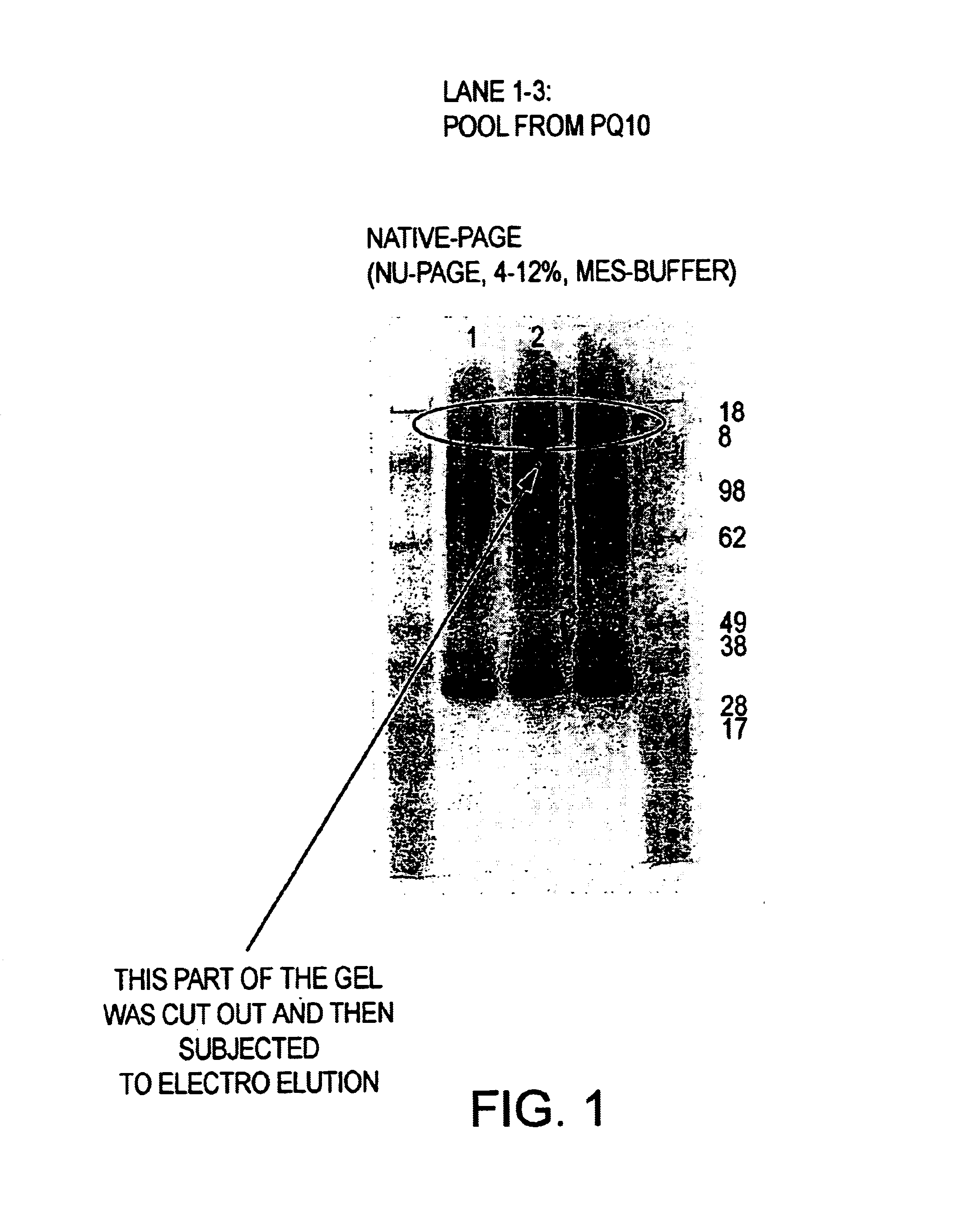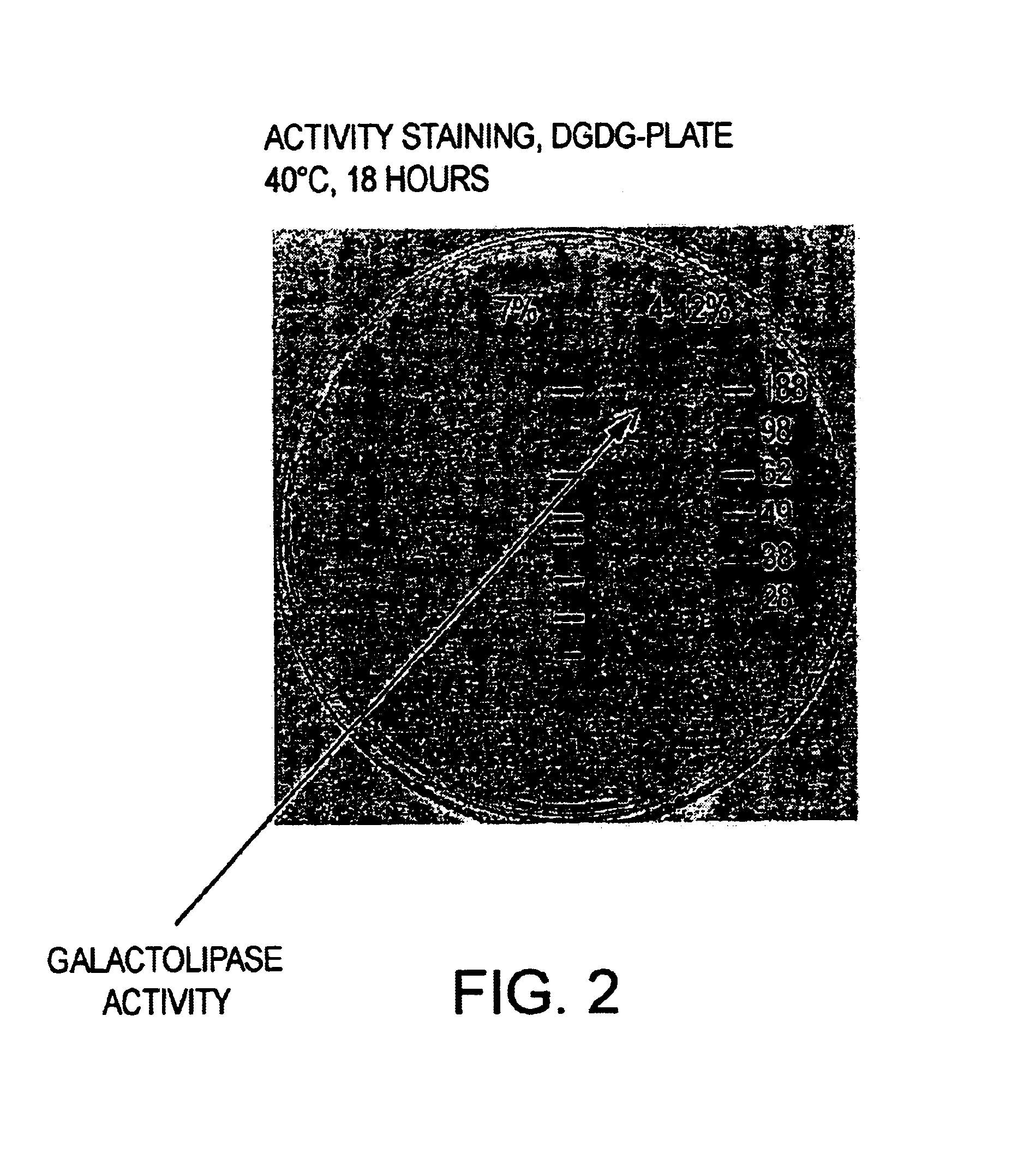Method of improving dough and bread quality
a technology of dough and quality, applied in the field of methods, can solve the problems of affecting the bread volume, affecting the activity of yeast, and affecting the quality of bread,
- Summary
- Abstract
- Description
- Claims
- Application Information
AI Technical Summary
Benefits of technology
Problems solved by technology
Method used
Image
Examples
example 1
[0380]In the first series of dough experiments purified cowpea LAH was tested in 10 g dough in different concentrations in order to test the activity of the enzyme in dough and in order to find a suitable dosage for baking experiments. The activity of the enzyme was measured by analysing the level of free fatty acid in dough. The results are shown in Table 1 and FIG. 4.
[0381]
TABLE 1Effect of Cowpea LAH in Model DoughCowpea LAHFatty acid in doughUnits / kg flour‰33.440.62.550.122.130.0241.780.00481.6601.77
[0382]The results detailed in Table 1 and FIG. 4 clearly show that LAH from cowpea is active in dough during the production of free fatty acid.
[0383]Lipids extracted from the dough were further analysed by HPLC in order to study the effect on polar lipids in the dough.
[0384]Results from the HPLC analyses of dough lipids are shown in Table 2 and FIGS. 5 and 6.
[0385]
TABLE 2HPLC analysis of polar lipids in dough.Cowpea LAH‰‰‰‰Units / kg flourDGDGPCDGMGLPC02.110.370.191.360.00482.220.520.20...
example 2
[0391]Cowpea LAH was tested in minibread analysis in two different concentrations and compared to a control (without cowpea LAH added). The volume of the bread was evaluated as well as an evaluation of crumb structure and appearance. Fully proofed dough from this test was frozen and freeze dried and the dough lipid extracted. Isolated dough lipids were analysed by HPLC and GLC analysis.
[0392]The results from the baking test is shown in Table 3.
[0393]
TABLE 3Baking Test with Cowpea LAHTestCowpea LAHBread volumeFatty acidno.% in doughml / gin dough, ‰103.092.6320.053.112.7530.153.32.96
[0394]Cowpea LAH clearly contributed to increased volume of the baked bread compared to the control, and the enzyme also contributed to improved crumb, with a more homogenous structure and a better appearance.
[0395]Results from lipid analysis of extracted lipids are shown in Table 4.
[0396]
TABLE 4GLC and HPLC Analyis of Dough LipidsTestMonoglycerideDiglycerideTriglycerideDGDGDGMGno.‰‰‰‰‰10.430.994.942.090.22...
example 3
[0398]LAH isolated from cowpea was evaluated in baking tests as follows. The LAH was evaluated in hard crust rolls.
[0399]LAH was tested in a dosage of 0, 0.25, 0.5, 1 or 1.5 units enzyme / kg flour). Initial results show that the addition of 1.5 mg of LAH increased the loaf volume of the bread by more than 10% compared with bread with no enzyme and improved the dough handling properties.
PUM
| Property | Measurement | Unit |
|---|---|---|
| temperature | aaaaa | aaaaa |
| total volume | aaaaa | aaaaa |
| pH | aaaaa | aaaaa |
Abstract
Description
Claims
Application Information
 Login to View More
Login to View More - R&D
- Intellectual Property
- Life Sciences
- Materials
- Tech Scout
- Unparalleled Data Quality
- Higher Quality Content
- 60% Fewer Hallucinations
Browse by: Latest US Patents, China's latest patents, Technical Efficacy Thesaurus, Application Domain, Technology Topic, Popular Technical Reports.
© 2025 PatSnap. All rights reserved.Legal|Privacy policy|Modern Slavery Act Transparency Statement|Sitemap|About US| Contact US: help@patsnap.com



